Ehira Six and Astoria Super Six
The Ehira Six and Astoria Super Six are Japanese 6×6 coupled-rangefinder folding cameras. They were made by Ehira Kōki Seisakusho from 1949.[1]
Contents
Description of the body
The Ehira Six and Astoria Super Six are horizontal folders, strongly inspired by the Super Ikonta. The body is perhaps based on the body of the Weha Chrome Six rigid model.
There is a combined range- and viewfinder. The viewfinder window is offset to the left and the second image window is to the right. The lens is front-cell focusing and the rangefinder coupling is optical, with no mechanical linkage: the front element of the lens is geared to an optical device placed in front of the second image window and focusing is controlled by a small wheel protruding from the lens casing. It is not known if the optical coupling lens is a wedge prism as on the Super Ikonta and other Zeiss Ikon models or a laterally moving lens as on the earlier Weha Chrome Six, also made by Ehira.
The advance knob is at the top right and there is a body release next to it. The accessory shoe is in the middle, flush with the top plate. The folding bed release is in front of the accessory shoe. The back is hinged to the left. The folding struts are engraved with the EHIRA K.S.K logo.
The lens is a Lausar 85mm f/3.5 by Tomioka and the shutter gives B, 1–400 speeds.
Advertising
The camera was advertised as the Ehira Six IIIA (エヒラシックスⅢA型) in November 1949.[2] Three authorized dealers were mentioned: the Osaka branch of Tōyō Shashinki-zai, Sanseisha (㈱三青社) and Nippō Shōji (日邦商事㈱). In the text, the shutter is called Serea Rapid (セレアラピッド) and said to give T, B, 1–400 speeds; but in the picture, the bottom of the shutter plate is marked EHIRA RAPID.
Actual examples
Ehira Six
One of the two actual examples of the Ehira Six IIIA observed so far has a black rangefinder arm, the EHIRA RAPID marking at the bottom of the lens casing and an EHIRA SIX marking above the top plate.[3] The other one, pictured here, has a chrome-plated rangefinder arm inscribed with the text PATENT and a Lausar 85mm f/3.5 lens in an EHIRA RAPID leaf shutter (B, 1–400).
  
|
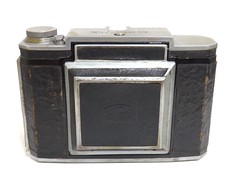  
|
| Ehira Kohki, Ehira Six IIIA, 6x6cm, Lauser f3.5/85mm lens, Ehira Rapid shutter Images by yalluflex. (Image rights) |
Astoria Super Six
The same camera also exists as the Astoria Super Six IIIB. Two examples are pictured in Sugiyama.[4] The only visible difference with the Ehira Six IIIA is the chrome-plated rangefinder arm inscribed PATENT and certainly the marking above the top plate. One example has EHIRA RAPID at the bottom of the lens casing (as the previous model) and a Lausar C lens marking, certainly indicating a coated lens. The other has ASTORIA SYNCHRO instead of EHIRA RAPID.
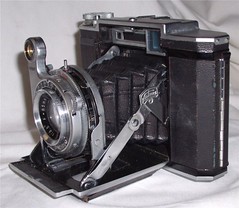 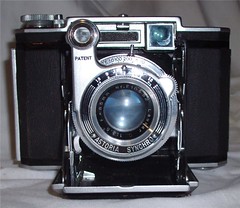 
| |
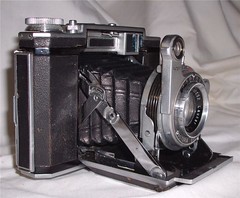  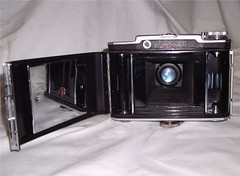
| |
| Astoria Super Six IIIB no.A1814, Astoria Synchro shutter (B, 1–400), Lausar C. 85mm f/3.5 no.E10552. Pictures courtesy of eBayer ms.winchester. (Image rights) | |
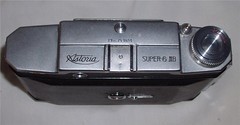 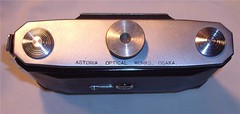
| |
| Astoria Super Six IIIB, top and bottom plates. Pictures courtesy of eBayer ms.winchester. (Image rights) | |
Notes
- ↑ Date: Kokusan kamera no rekishi, p.347; Lewis, p.67.
- ↑ Advertisement published in Asahi Camera, reproduced in Kokusan kamera no rekishi, p.121.
- ↑ Example pictured in Sugiyama, item 1296, and in Omoide no supuringu-kamera-ten, p.14.
- ↑ Sugiyama, items 1271–2.
Bibliography
- Asahi Camera (アサヒカメラ) editorial staff. Shōwa 10–40nen kōkoku ni miru kokusan kamera no rekishi (昭和10–40年広告にみる国産カメラの歴史, Japanese camera history as seen in advertisements, 1935–1965). Tokyo: Asahi Shinbunsha, 1994. ISBN 4-02-330312-7. Item 401.
- Lewis, Gordon, ed. The History of the Japanese Camera. Rochester, N.Y.: George Eastman House, International Museum of Photography & Film, 1991. ISBN 0-935398-17-1 (paper), 0-935398-16-3 (hard). Pp.67–8.
- McKeown, James M. and Joan C. McKeown's Price Guide to Antique and Classic Cameras, 12th Edition, 2005-2006. USA, Centennial Photo Service, 2004. ISBN 0-931838-40-1 (hardcover). ISBN 0-931838-41-X (softcover). P.255.
- Omoide no supuringu-kamera-ten (思い出のスプリングカメラ展, Exhibition of beloved self-erecting cameras). Tokyo: JCII Camera Museum, 1992. (Exhibition catalogue, no ISBN number.) P.14.
- "Shirarezaru kamera: Ehira Six IIIA, Astoria Super Six IIIB" (知られざるカメラ・エヒラシックスⅢA・アストリアスーパーシックスⅢB, "Unknown cameras: Ehira Six IIIA, Astoria Super Six IIIB"). Kamera Rebyū: Kurashikku Kamera Senka (カメラレビュー クラシックカメラ専科) / Camera Review: All about Historical Cameras no. 11, March 1988. Tokyo: Asahi Sonorama. (Not seen, but the title is given by this page at Kanroshobo.)
- Sugiyama, Kōichi (杉山浩一); Naoi, Hiroaki (直井浩明); Bullock, John R. The Collector's Guide to Japanese Cameras. 国産カメラ図鑑 (Kokusan kamera zukan). Tokyo: Asahi Sonorama, 1985. ISBN 4-257-03187-5. Items 1272 and 1296.